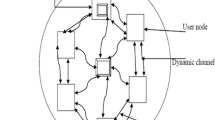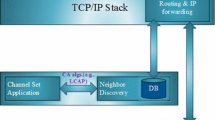Abstract
Multi-radio multi-channel WMNs are innovative technical kind of WMNs, i.e., the nodes with multi radios and numerous channels for communication. In wireless mesh routers of WMNs, multiple network interfaces caused due to multiple channels typically increases the network throughput, i.e., in multi-channel WMN, whenever two neighboring nodes transfer information using the similar channel, they might interfere with one another and eventually decreases the throughput. Thus, there is a need for an effective approach to reduce network interference and significantly enhance throughput. This paper primarily concentrates on issues of multicasts channel assignment in WMNs to diminish the interference in the network. The adaptive decision-making strategy of learning automata and strong searching capability of the genetic algorithm is employed in this approach. The methodology combined multicast tree construction and channel assignment, to evade that channel assignment could not function well with the specific multicast tree. In this paper, the initial multicast tree construction by learning automata and the optimal channel assignment is performed by genetic algorithm. The experiment outcomes for the suggested methodology is carried out using NS2 and performance efficiency is matched with LAMR, LCA, and GA based multicast channel assignment approach and suggested higher performance using packet delivery ratio, an end to end delay, throughput and total cost.









Similar content being viewed by others
References
Cordeiro, C., Gossain, H., & Agrawal, D. (2003). Multicast over wireless mobile ad hoc networks: present and future directions. IEEE Network, 17(1), 52–59.
Wang, X., Cao, J., Cheng, H., & Huang, M. (2006). QoS multicast routing for multimedia group communications using intelligent computational methods. Computer Communication, 29(12), 2217–2229.
Din, D. (2005). Anycast routing and wavelength assignment problem on WDM network. IEICE Transactions on Communications, 88(10), 3941–3951.
Zhang, Y., Luo, J., & Hu, H. (2006). Wireless mesh networking: architectures, protocols and standards. New York: Auerbach Publications.
Wang, B., & Hou, J. (2000). A survey on multicast routing and its QoS extensions: problems, algorithms, and protocols. IEEE Network Magazine, 14(1), 22–36.
Subramanian, A.P., Gupta, H., Das, S.R., Cao, J. (2007). Minimum interference channel assignment in multi-radio wireless mesh networks. In Proceedings of IEEE SECON.
Kumar, N., Kumar, M., & Patel, R. B. (2011). Capacity and interference aware link scheduling with channel assignment in wireless mesh networks. Journal of Network and Computer Applications, 34(1), 30–38.
Zeng, G., Wang, B., Ding, Y., Xiao, L., Mutka, M. (2007). Multicast algorithms for multi-channel wireless mesh networks. In Proceedings of the IEEE international conference on network protocols, ICNP, pp. 1–10. Beijing, China.
Ma, L., Zhu, G., Yin, B. (2008). Optimization models of multi-channel assignment in multi-radio wireless mesh networks. In 4th international conference on wireless communications, networking and mobile computing, pp 1–5.
Baul, P., Adya, A., Padhye, J., & Walman, A. (2004). Reconsidering wireless systems with multiple radios. ACM SIGCOMM Computer Communication Review, 34(5), 39–46.
Das, A., Vijayakumar, R., Roy, S. (2006). Static channel assignment in multi-radio multi-channel 802.11 wireless mesh networks: issues, metrics and algorithms. In 49th IEEE global telecommunications conference (GLOBECOM), San Francisco, California, USA.
Gupta, P., & Kumar, P. R. (2000). The capacity of wireless networks. IEEE Transactions on Information Theory, 46(2), 388–404.
Raniwala, A., Gopalan, K., & Chiueh, T. (2004). Centralized channel assignment and routing algorithms for multi-channel wireless mesh networks. ACM SIGMOBILE Mobile Computing and Communication Review, 8(2), 50–65.
So, J., Vaidya, N. (2004). Multi-channel MAC for ad hoc networks: handling multi-channel hidden terminals using a single transceiver. In Proceedings of ACM Mobile Hoc, pp. 222–233.
Raniwala, A., Chiueh, T.(2005). Architecture and algorithms for an IEEE 802.11-based multi-channel wireless mesh network. In Proceedings of IEEE INFOCOM, pp. 2223–2234.
Youssef, H., Almulhem, A., Sait, S. M., & Tahir, M. A. (2002). QoS-driven multicast tree generation using tabu search. Computer Communications, 25(11–12), 1140–1149.
Ahn, C., & Ramakrishna, R. (2002). A genetic algorithm for shortest path routing problem and the sizing of populations. IEEE Transactions on Evolutionary Computation, 6(6), 566–579.
Cheng, H., & Yang, S. (2011). Joint QoS multicast routing and channel assignment in multiradio multichannel wireless mesh networks using intelligent computational methods. Applied Soft Computing, 11(2), 1953–1964.
Jahanshahi, M., Dehghan, M., Meybodi, M. R., & Un, A. (2013). LAMR: learning automata based multicast routing protocol for multi-channel multi-radio wireless mesh networks. Journal of Applied Intelligence, 38(1), 58–77.
Cheng, H., & Yang, S. (2011). Joint QoS multicast routing and channel assignment in multi radio multi-channel wireless mesh networks using intelligent computational methods. International Journal of Applied Soft Computing, 11(2), 1953–1964.
Musham, R. et. al. (2016). Near optimal channel assignment for interference mitigation in wireless mesh networks. In IEEE international conference on advanced networks and telecommunications systems (ANTS), June 2017.
Choi, S., & Park, J. H. (2016). Minimum interference channel assignment algorithm for multicast in a wireless mesh network. Sensors., 16(12), 2056.
Farmani, B., Jaseemuddin, M. and Batarfi, O., IMRP: interference-aware multicast routing for wireless mesh networks. In 2017 IEEE 30th canadian conference on electrical and computer engineering (CCECE).
Nguyen, H.L. and Nguyen, U.T. (2008). Minimum interference channel assignment for multicast in multi-radio wireless mesh networks. In Proceedings of IEEE international wireless communications and mobile computing conference (IWCMC’08).
Yin, Z., Li, Z. and Chen, M. (2007).A novel channel assignment algorithm for multicast in multi-radio wireless mesh networks. In Proceedings of IEEE international conference on network protocols (ICNP’07).
Author information
Authors and Affiliations
Corresponding author
Additional information
Publisher's Note
Springer Nature remains neutral with regard to jurisdictional claims in published maps and institutional affiliations.
Rights and permissions
About this article
Cite this article
Balusu, N., Pabboju, S. & Narsimha, G. An Intelligent Channel Assignment Approach for Minimum Interference in Wireless Mesh Networks Using Learning Automata and Genetic Algorithms. Wireless Pers Commun 106, 1293–1307 (2019). https://doi.org/10.1007/s11277-019-06214-3
Published:
Issue Date:
DOI: https://doi.org/10.1007/s11277-019-06214-3




